UMass Extension's Landscape Message is an educational newsletter intended to inform and guide Massachusetts Green Industry professionals in the management of our collective landscape. Detailed reports from scouts and Extension specialists on growing conditions, pest activity, and cultural practices for the management of woody ornamentals, trees, and turf are regular features. The following issue has been updated to provide timely management information and the latest regional news and environmental data.
The Landscape Message will be updated weekly in May. The next message will be posted on May 20. To receive immediate notification when the next Landscape Message update is posted, be sure to join our e-mail list
To read individual sections of the message, click on the section headings below to expand the content:
Scouting Information by Region
Environmental Data
The following data was collected on or about May 11, 2022. Total accumulated growing degree days (GDD) represent the heating units above a 50° F baseline temperature collected via regional NEWA stations (http://newa.cornell.edu) for the 2022 calendar year. This information is intended for use as a guide for monitoring the developmental stages of pests in your location and planning management strategies accordingly.
|
MA Region/Location |
GDD |
Soil Temp |
Precipitation |
Time/Date of Readings |
|||||
|
1-Week Gain |
2022 Total |
Sun |
Shade |
||||||
|
CAPE |
14 (BE= 117) |
46 |
50 |
48 |
0.42 |
12:00 PM 5/11 |
|||
|
SOUTHEAST |
27 |
97 |
61 |
51 |
0 |
3:00 PM 5/11 |
|||
|
NORTH SHORE |
19 |
66 |
52 |
45 |
0 |
10:00 AM 5/11 |
|||
|
EAST |
31 |
111 |
59 |
54 |
0.01 |
4:00 PM 5/11 |
|||
|
METRO |
34 |
85 |
47 |
45 |
0.13 |
6:00 AM 5/11 |
|||
|
CENTRAL |
30 |
71 |
54 |
57 |
0.01 |
1:00 PM 5/11 |
|||
|
PIONEER VALLEY |
43.5 |
92.5 |
54 |
50 |
0 |
11:00 AM 5/11 |
|||
|
BERKSHIRES |
37 |
70 |
52 |
46 |
0 |
7:45 AM 5/11 |
|||
|
AVERAGE |
29 |
80 |
54 |
50 |
0.07 |
_ |
|||
|
* = information not available |
|||||||||
As of 5/10, there are abnormally dry (D0) conditions in parts of 6 eastern MA counties: Massachusetts | U.S. Drought Monitor (unl.edu)
Phenology
| Indicator Plants - Stages of Flowering (BEGIN, BEGIN/FULL, FULL, FULL/END, END) | ||||||||
|---|---|---|---|---|---|---|---|---|
| PLANT NAME (Botanic / Common) | CAPE | S.E. | N.S. | EAST | METRO W. | CENT. | P.V. | BERK. |
|
Spiraea x vanhouttei (Vanhoutte spirea) |
Begin |
Full |
Begin |
Begin |
Begin |
Begin |
Begin |
* |
|
Elaeagnus umbellata (autumn olive) |
* |
Begin |
Begin |
Begin |
Begin |
Begin |
Begin |
* |
|
Syringa vulgaris (common lilac) |
Begin/Full |
Full |
Begin/Full |
Begin/Full |
Begin/Full |
Begin |
Begin/Full |
Begin |
|
Cornus florida (flowering dogwood) |
Begin/Full |
Full |
Full |
Full |
Full |
Begin/Full |
Full |
Begin |
|
Rhododendron spp. (early azaleas) |
Begin/Full |
Full |
Full |
Begin/Full |
Full |
Full |
Full |
Full |
|
Malus spp. (crabapple) |
Full |
End |
Full |
Full |
Full/End |
Full |
Full |
Begin/Full/End |
|
Cercis canadensis (redbud) |
Full |
Full |
Full |
Full |
Full |
Full |
Full |
Begin/Full |
|
Rhododendron 'P. J. M.' |
End |
End |
Full/End |
End |
End |
End |
Full/End |
Full/End |
|
Magnolia soulangiana (saucer magnolia) |
End |
End |
Full/End |
Full/End |
Full/End |
Full/End |
Full/End |
Full/End |
| * = no activity to report/information not available | ||||||||
Regional Notes
Cape Cod Region (Barnstable)
General Conditions:The average temperature for the period from May 4 – May 11 was 49ᐤF with a low of 43ᐤF on May 6 and a high of 63ᐤF on May 6. The period included only one completely sunny day, 2 cloudy days and the majority partly cloudy. Light precipitation fell on May 6, 7 & 11 totaling less than half an inch. The period has also been dominated by sustained winds out of the Northeast since May 7, which has kept it feeling rather cool for May and plant development has been slow over the period. Soil moisture is adequate. Herbaceous plants seen in bloom between 5/4 and 5/11 include tulip (Tulipa spp.), grape hyacinth (Muscari armeniacum), creeping phlox (Phlox subulata), bleeding heart (Dicentra spectabilis, D. eximia), yellow alyssum (Aurinia saxatilis), pulmonaria (Pulmonaria officinalis) barrenwort (Epimedium spp.), little merry bells (Uvularia sessilifolia), foam flower (Tiarella cordifolia), Solomon’s seal (Polygonatum falcatum), and spotted geranium (Geranium maculatum). Woody plants, in addition to the species in the phenology table above, currently in bloom include Korean spice viburnum (Viburnum carlesii), serviceberry (Amelanchier canadensis), highbush blueberry (Vaccinium corymbosum), sassafras (Sassafras albidum), and beach plum (Prunus maritima). Japanese cherry ‘Kwanzan’ (Prunus serrulata ‘Kwanzan’) is in full bloom.
Pests/Problems: Winter moth larvae so far are fairly hard to find. Damage has been observed on rose, blueberry, apple and Japanese maple. Winter moth is no longer considered an important forest pest on the Cape nor is it likely to impact the health of ornamentals and thus no longer requires widespread management. Control may be required for fruit bearing apples and blueberries. White pine needle disease can be seen on white pine (P. strobus) and needlecast can also be seen on pitch pine (P. rigida). Damage from the previous growing season on boxwood (leafminer damage) and on andromeda (lacebug) are apparent. Hemlock woolly adelgid was observed on hemlock. Many samples of rhododendron have come into the office with leafspots and abiotic injuries such as winter burn. Weeds in bloom include hairy bittercress (Cardamine hirsuta), mouse-ear cress (Arabidopsis thaliana), yellow rocket (Barbarea vulgaris), shepherd's purse (Capsella bursa-pastoris), thymeleaf speedwell (Veronica serpyllifolia), garlic mustard (Alliaria petiolata), dandelion (Taraxacum officinale), common violet (Viola sororia), and cypress spurge (Euphorbia cyparissias). Rabbits are abundant. Keep yourself protected from dog ticks and deer ticks.
Southeast Region (Dighton)
General Conditions: The week was dominated by a sustained strong wind from the North. This has resulted in cool dry weather. Plants seen in flower include: Ajuga reptans (bugleweed), Allium spp. (ornamental onion), Aquilegia spp. (columbine), Aurina saxitalis (basket of gold), Betula populifolia (gray birch), Conium maculatum (poison hemlock), Convillaria majalis (lily of the valley), Dicentra formosa (western bleeding heart), Fothergillia spp., Fragaria x ananassa (strawberry), Geranium maculatum (crane's bill), G. sanguineum (bloody geranium), Halesia carolina (Carolina silverbell), Hesperis matronalis (dame's rocket), Lunaria annua (honesty), Ornithogalum umbellatum (star of Bethlehem), Paulownia tomentosa (empress tree), Pieris japonica (Japanese andrometer), Phlox stolonifera (creeping phlox), Polygonatum biflorum (solomon's seal), Prunus maritima (beach plum), P. x cistena (purple leaved sand cherry), P. serrulata 'Kanzan' (Kwanzan cherry), Quercus rubra (red oak), Rhododendron vaseyi (pinkshell azalea), R. 'Olga Mezitt', Syringa vulgaris (common lilac), Trillium grandiflorum (white trillium) T. sessile (toad shade), Tulpia spp., Vaccinium corymbosum (highbush blueberry), Vinca minor (myrtle), and Wisteria sinensis (Chinese wisteria),
Pests/Problems: European pine sawfly was found on mugo pine and eastern tent caterpillar on crab apple.
North Shore (Beverly)
General Conditions: The weather this reporting period was dry with clear sunny skies, mild day temperatures and cold temperatures at night. Daytime temperatures were in the low to mid-50s except on May 5th when the day temperature went up to 68°F. Night temperatures were in the mid 30s to the low and mid-40s. The average daily temperature for this period was 49°F with the maximum temperature of 68°F recorded on May 5 and minimum temperature of 34°F recorded on May 9. No precipitation was recorded at Long Hill during this period. Woody plants in full bloom in addition to those in the phenology table above include: mountain pieris (Pieris floribunda), large fothergilla (Fothergilla major), dwarf fothergilla (Fothergilla gardenii), royal azalea (Rhododendron schlippenbachii), common lilac (Syringa vulgaris), Kwanzan cherry (Prunus serrulata), cucumber tree (Magnolia acuminata), hardy orange (Poncirus trifoliata), Olga Mezitt rhododendron (Rhododendron ‘Olga Mezitt’) and highbush blueberry (Vaccinium corymbosum). Some of the non-woody plants seen in bloom include: daffodil (Narcissus spp.), forget-me-not (Myosotis sylvatica), tulips (Tulipa spp.), old fashioned bleeding heart (Dicentra spectabilis), pachysandra (Pachysandra procumbens), vinca vine (Vinca minor), and honesty plant (Lunaria annua).

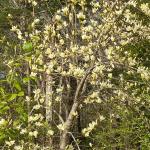

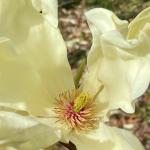
Pests/Problems: Due to the dry conditions and strong winds, fire danger weather alerts have been posted in many areas in the region.* Many homeowners and landscapers continue to do spring cleanup and to apply mulch on perennial gardens and under ornamental trees and shrubs. Some of the weeds seen in bloom include: dandelion (Taraxacum officinale), ground ivy (Glechoma hederacea), common blue violets (Viola spp.), garlic mustard (Alliaria petiolata), and purple deadnettle (Lamium purpureum). Ticks and mosquitoes are active. Take care to protect yourself when working outdoors.
*[ ed.note, update Massachusetts | U.S. drought Monitor (unl.edu) ]
East Region (Boston)
General Conditions: The past week was dominated by cool mornings, windy days and relatively warm sunny afternoons. Temperatures averaged 59ᐤF with a high of 70ᐤF on May 5th. Overnight temperatures averaged 45ᐤF with a low of 39ᐤF on the morning of the 11th. Turf has greened up and most have received their first mowing. Plants in bloom include; Arisaema triphyllum (Jack in the pulpit), Dodecatheon meadia (shooting star), Fothergilla spp. (fothergilla, fragrant witch alder), Galium odoratum (sweet woodruff), Iberis sempervirens (candytuft), Phlox subulata (creeping phlox) and Prunus maritima (beach plum). ‘Kwanzan’ cherry (Prunus serrulata ‘Kwanzan’) are in full bloom and adding an abundance of color to many neighborhoods.
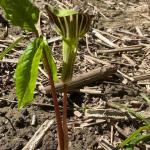 Pests/Problems: Soils are dry.* We received 0.01 inches of precipitation over the past week for a total of 0.35 inches for May. New plantings require supplemental irrigation. Hydrangea leaftier (Olethreutes ferriferana) caterpillars continue sewing up the foliage of susceptible Hydrangea. Boxwood leafminer (Monarthropalpus flavus) adult flies have been observed swarming boxwoods. Garlic mustard (Alliaria petiolata) second year rosettes continue to flower while first year seedlings are germinating on any available soil. Celandine poppy, the greater celandine (Chelidonium majus) is in flower. Japanese knotweed (Polygonum cuspidatum) shoots are 2-3 feet tall. Dandelion (Taraxacum officinale) are flowering and going to seed.
Pests/Problems: Soils are dry.* We received 0.01 inches of precipitation over the past week for a total of 0.35 inches for May. New plantings require supplemental irrigation. Hydrangea leaftier (Olethreutes ferriferana) caterpillars continue sewing up the foliage of susceptible Hydrangea. Boxwood leafminer (Monarthropalpus flavus) adult flies have been observed swarming boxwoods. Garlic mustard (Alliaria petiolata) second year rosettes continue to flower while first year seedlings are germinating on any available soil. Celandine poppy, the greater celandine (Chelidonium majus) is in flower. Japanese knotweed (Polygonum cuspidatum) shoots are 2-3 feet tall. Dandelion (Taraxacum officinale) are flowering and going to seed.
*[ed. note, update Massachusetts | U.S. drought Monitor (unl.edu) ]
Metro West (Acton)
General Conditions: Dry, windy, and cool sums up last week’s weather. Little precipitation was recorded, strong winds continued, and moderate temperatures were recorded for this past week. A high temperature of 72°F was recorded on the 5th and a low of 36°F was recorded on the 9th. According to NOAA, the 20-year average rainfall total for the month of May is 3.37”and total precipitation recorded for the month so far is 0.31”. Much is in bloom at this time of the year, including the following woody plants: Aronia arbutifolia (red chokeberry), Daphne x burkwoodii 'Carol Mackie' (daphne), Malus spp. (apple, crabapple), Spiraea spp. (bridal wreath), Syringa spp. (early blooming lilac), S. vulgaris (common lilac), Vaccinium angustifolium (lowbush blueberry), V. corymbosum (highbush blueberry), Viburnum x burkwoodii (Burkwood viburnum) and V. x burkwoodii 'Mohawk' (Mohawk Burkwood viburnum), and Viburnum x juddii (Judd viburnum). Contributing even more color and interest to the landscape are some flowering herbaceous plants and spring ephemerals including Caltha palustris (marsh marigold), Dicentra canadensis (squirrel corn), D. cucullaria (Dutchman's breeches), D. spectabilis (old fashioned bleeding heart), Epimedium x versicolor cultivars (flowering barrenwort), Erythronium americanum (yellow trout-lily), Galium odoratum (sweet woodruff), Lunaria annua (money plant), Myosotis sylvatica (forget-me-not), Phlox subulata (moss phlox), Polygonatum odoratum 'Variegatum' (fragrant Solomon’s seal), Tiarella cordifolia (foam flower), Trillium erectum (red flowering trillium), T. grandiflorum (white flowering trillium), T. sessile (toadshade trillium), Uvularia sessilifolia (bellflower/little merry bells/wild oats), and Waldsteinia ternata (barren strawberry).
Pests/Problems: Ticks, mosquitoes and black flies are feeding and active. Many weeds are in flower including a few of the nastiest invasives of all time, Alliaria petiolata (garlic mustard) which is easily seen with its white flowers growing on roadsides and in woodlands, wetlands and gardens, Elaeagnus umbellata (autumn-olive), and Lonicera maackii (Amur honeysuckle). Other weeds seen in bloom now are Glechoma hederacea (ground ivy), Lamium purpureum (purple dead nettle) and Taraxacum officinale (dandelion).
Central Region (Boylston)
General Conditions: The precipitation pattern we have been experiencing seems to be more typical than not in recent years. After a below average amount of rainfall in March and April, the first half of May appears to be abnormally dry as well. Although the U.S. drought monitor is not yet showing that our region is abnormally dry, the data were last updated on May 3. With virtually no rain this reporting period, that status is likely to change with the next update*. Aside from the lack of rain, temperatures have been cool, extending what has turned out to be a fantastic spring for flowering plants. Tulips are in full swing, lilacs are starting to open, magnolias and crabapples are still going strong, and many of our native spring ephemerals and woodland perennials are in full bloom, including Trillium grandiflorum (white trillium) and Phlox divaricata (wild blue phlox). Orioles and hummingbirds were spotted this reporting period.
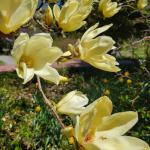


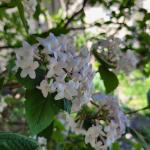 Pests/Problems: The early stages of drought is a concern. Otherwise, no notable pest or disease problems presently. Ticks, mosquitoes, slugs, black flies, and groundhogs are all active.
Pests/Problems: The early stages of drought is a concern. Otherwise, no notable pest or disease problems presently. Ticks, mosquitoes, slugs, black flies, and groundhogs are all active.
*[ed. Note, update: Massachusetts | U.S. drought Monitor (unl.edu) ]
Pioneer Valley Region (Amherst)
General Conditions: Spring is reaching its zenith here in the Pioneer Valley as we approach the midpoint of May. Nearly every plant in the landscape, save for a few holdouts, is pushing new growth at this time. There’s a profusion of color and a variety of trees and shrubs appear absolutely incredible. Redbuds and crabapples are having a strong year, as they often do. Bees, wasps and other pollinators are everywhere. Overall, it’s been a cool spring, which has helped to prolong the flowering period for many plants (cherries seemed to have a long flowering period). This past week was no different, with cool and breezy conditions in the tri-counties. The cool to cold nights seem to have been keeping black fly and mosquito populations down. But with warm weather on the horizon and a lack of rainfall over the past few weeks, the spring honeymoon is over. Meaning, it’s watering/weeding season and biting insects will be out in force. Prior to Monday, 5/9, cloudy skies had dominated the month of May (5/2–4 and 5/6–7). But a steady dose of full sun this week has changed the narrative and combined with the dogged winds and lack of rain; the upper soil horizon is drying out. That said, there’s still ample moisture in lower soil horizons, so attention right now should be paid to recently (past three years) transplanted trees and shrubs. A patchy (and final?) frost occurred on the morning of 5/9 with temperatures low enough to freeze over a bird bath and kill tender garden seedlings. Turfgrasses are growing strong and lawn weeds are in flower, such as dandelion and violet.
Pests/Problems: We’re still dealing with the fallout from winter injury. Identify and prune out dead branches and leaves from evergreens such as arborvitae, rhododendron, holly and andromeda. Dark-colored aphids were observed on Japanese maples. They were clustered in large groups at the base of newly developing shoots and individually on the underside of young foliage. Cankering fungi are active and any dead branches/stems in the canopy of the most susceptible trees (those weakened by other stresses or with very thin bark) should be pruned out. Continue to scout for symptoms of beech leaf disease as beech leaves expand. Dark-colored, interveinal banding and convex cupping (when viewed from the upper leaf surface) are the most notable symptoms at this time. We are entering a time period when foliar anthracnose infections can develop. Last year, maple anthracnose was widespread and symptoms are often most visible in early to mid-June. While spongy moth populations are locally high in the Berkshires and Litchfield County, CT, this omnivorous pest does not seem to be abundant this year in the Pioneer Valley. However, this is based on limited scouting and the next few weeks will reveal where the spongy moth is active. Hemlock looper (Lambdina spp.) populations were high in parts of Franklin County in 2021. Caterpillars of this native forest pest defoliated a significant number of trees, causing mortality to some. Carefully scout hemlocks in late May to early June for symptoms of needle feeding and for the small, green-colored caterpillars. Bt applications can be effective during the early instars but other insecticides (e.g. spinosad) will be required for later instars. Treatment is only required when populations are high; at low levels, natural predators should control the pest. As pine candles continue to elongate and new needles emerge, consider preventative fungicide applications if needle blights have been a problem in the past. Protecting the current season’s growth can help to break the repeated cycle of infection.
Berkshire Region (Great Barrington)
General Conditions: It would seem that in a matter of a few days, the weather has gone from early spring at the beginning of this scouting period to early summer at the end of the period. Cool temperatures exacerbated by high winds occurred late last week and over the weekend with temperatures mostly in the mid-50s. Scattered frost occurred on the morning of May 9th. By Tuesday, May 10th, temperatures have dramatically risen into the 70s with the expectation of 80ᐤF temperatures to finish the week. Winds have been persistent and now, with rising temperatures, soil moisture levels are rapidly declining. As yet, this has not affected growth of turf grass. Dandelion (Taraxacum officinale), sweet/wood violet (Viola odorata), bluets (Houstonia caerulea), and wild strawberry (Fragaria vesca) are among the species that are blooming in many lawns at this time. While some may find these to be problems, others view them as important contributors to the survival of bees which feed on the nectar and pollen produced by the flowers.
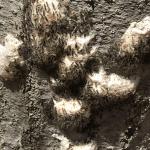
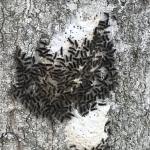
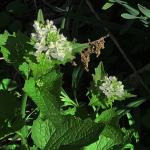 Pests/Problems: Spongy moth (Lymantria dispar) caterpillars were sighted hatching this past Monday (May 9) from egg masses on the bark of oaks. From the numbers of egg masses and huge quantity of hatched caterpillars it appears that the Berkshires will again see considerable defoliation of oaks and other deciduous trees this year. Spruce spider mite was found on dwarf Alberta spruce (Picea glauca 'Conica'). Hemlock wooly adelgid and elongate hemlock scale were also observed. Winter desiccation injury continues to be found, mainly on spruce. The black-legged tick population remains very high and tick bites are common. Weed development has accelerated as temperatures have warmed. Garlic mustard (Alliaria petiolata), a prominent invasive weed, is now in bloom.
Pests/Problems: Spongy moth (Lymantria dispar) caterpillars were sighted hatching this past Monday (May 9) from egg masses on the bark of oaks. From the numbers of egg masses and huge quantity of hatched caterpillars it appears that the Berkshires will again see considerable defoliation of oaks and other deciduous trees this year. Spruce spider mite was found on dwarf Alberta spruce (Picea glauca 'Conica'). Hemlock wooly adelgid and elongate hemlock scale were also observed. Winter desiccation injury continues to be found, mainly on spruce. The black-legged tick population remains very high and tick bites are common. Weed development has accelerated as temperatures have warmed. Garlic mustard (Alliaria petiolata), a prominent invasive weed, is now in bloom.
Regional Scouting Credits
- CAPE COD REGION - Russell Norton, Horticulture and Agriculture Educator with Cape Cod Cooperative Extension, reporting from Barnstable.
- SOUTHEAST REGION - Brian McMahon, Arborist, reporting from the Dighton area.
- NORTH SHORE REGION - Geoffrey Njue, Green Industry Specialist, UMass Extension, reporting from the Long Hill Reservation, Beverly.
- EAST REGION - Kit Ganshaw & Sue Pfeiffer, Horticulturists reporting from the Boston area.
- METRO WEST REGION – Julie Coop, Forester, Massachusetts Department of Conservation & Recreation, reporting from Acton.
- CENTRAL REGION - Mark Richardson, Director of Horticulture reporting from New England Botanic Garden at Tower Hill, Boylston.
- PIONEER VALLEY REGION - Nick Brazee, Plant Pathologist, UMass Extension Plant Diagnostic Lab, reporting from Amherst.
- BERKSHIRE REGION - Ron Kujawski, Horticultural Consultant, reporting from Great Barrington.
Woody Ornamentals
Diseases
Recent pests and pathogens of interest seen in the UMass Extension Plant Diagnostic Lab, a select few:
- Needle tip dieback on Alaska cedar (Callitropsis nootkatensis) caused by Phyllosticta. While fungal nomenclature changes often, it’s uncommon to see any change in the scientific names of known trees. That is not the case for Alaska cedar, which has bounced from several genera to where it’s currently housed (Callitropsis). Previously, the species was a member of Chamaecyparis, Cupressus and Xanthocyparis. While its taxonomic status may be in debate, there’s no doubt this tree is a supreme landscape conifer. This particular specimen is 20-years-old and has been present at its current site for four years. It resides in shade with lawn irrigation and well-drained, loam soils. Submitted branch segments had brown needle tips and the managing arborist noted lower canopy dieback. While Alaska cedar can tolerate some shade, it will not perform well in full shade. Phyllosticta is common on arborvitae (Thuja spp.) but is not a common pathogen on Alaska cedar. The shade and wetting of the foliage from lawn sprinklers are likely facilitating disease development.
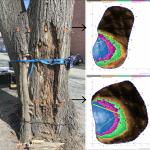 Lower trunk rot of American linden (Tilia americana) caused by Ganoderma applanatum. The artist’s conk pathogen has a broad host range among deciduous hardwoods and is capable of causing significant damage when well established. This mature tree had co-dominant leaders that bifurcated from a shared trunk at approximately 5’ above the soil line. Sometime in the past, the two leaders were cabled together, which likely saved the tree from wind-induced stem failure. The urban site had full sun but very poor soil conditions. The tree was entirely surrounded by a gravel driveway/parking area and was subject to repeated root zone compaction within the drip line. There was also regular foot traffic around the tree from pedestrians. On the northwest-west side of the lower trunk, the bark was missing and there was obvious decay present (see photo). In addition, there were numerous Ganoderma conks on the margins of the decaying wood and several conks higher up on the western co-dominant stem. Tomography scanning provided further insights on the severity of the decay. During the scanning process there were strong, gusty winds causing canopy sway. A large, vertical crack on the western co-dominant leader was opening and closing in response to the sway. The tree was deemed structurally unstable and removed the following day.
Lower trunk rot of American linden (Tilia americana) caused by Ganoderma applanatum. The artist’s conk pathogen has a broad host range among deciduous hardwoods and is capable of causing significant damage when well established. This mature tree had co-dominant leaders that bifurcated from a shared trunk at approximately 5’ above the soil line. Sometime in the past, the two leaders were cabled together, which likely saved the tree from wind-induced stem failure. The urban site had full sun but very poor soil conditions. The tree was entirely surrounded by a gravel driveway/parking area and was subject to repeated root zone compaction within the drip line. There was also regular foot traffic around the tree from pedestrians. On the northwest-west side of the lower trunk, the bark was missing and there was obvious decay present (see photo). In addition, there were numerous Ganoderma conks on the margins of the decaying wood and several conks higher up on the western co-dominant stem. Tomography scanning provided further insights on the severity of the decay. During the scanning process there were strong, gusty winds causing canopy sway. A large, vertical crack on the western co-dominant leader was opening and closing in response to the sway. The tree was deemed structurally unstable and removed the following day.- Dieback of Japanese maple (Acer palmatum ‘Bloodgood’) caused by Phomopsis. The tree is 35-years-old and grows in a mostly shaded setting with drip irrigation and well-drained soils. Tip dieback in the canopy was observed this spring and has occurred in the past (2017). The submitted sample had a mixture of healthy and diseased shoots with obvious symptoms of stem cankering. Healthy trees often harbor low level populations of this fungus and when various stresses develop (i.e. drought, winter injury, insect feeding, root disturbances, among others), the pathogen spreads and the disease develops. This is why “sanitation pruning” is so important in these trees. By removing any inoculum that can initiate an outbreak, the trees are better protected when stressed.
- Marginal leaf browning and branch tip dieback of rhododendron (Rhododendron ‘Anah Kruschke’ and R. ‘Chionoides’) caused by winter burn. Several plants were transplanted in spring of 2021 and appeared healthy entering the winter months. They reside in part sun/shade and receive drip irrigation in well-drained soils. However, in late winter they began exhibiting symptoms of winter injury and now appear severely damaged. The first winter following transplanting can be difficult for rhododendrons and it can take injured plants several years to recover. In these cases, removal and replacement of the shrubs may be a better option, in comparison to rehabilitating the existing plants.
Report by Nick Brazee, Plant Pathologist, UMass Extension Plant Diagnostic Lab, UMass Amherst.
Insects
An Update about Neonicotinoid Use in Massachusetts:
Beginning July 1, 2022 systemic insecticide active ingredients known as neonicotinoids will become state restricted use for tree and shrub uses in Massachusetts. If an individual works in the commercial industry (landscapers, arborists, etc.), then a Commercial Certification License is needed. (Example: Category 36 Commercial Certification License, Shade Trees & Ornamentals.) Someone can use a state or federal restricted use pesticide if they have a Commercial Applicators License as long as they are working under the direct supervision of someone with a Commercial Certification. Unlicensed or uncertified individuals will no longer be able to apply neonicotinoids to manage insect pests of trees and shrubs in Massachusetts.
More information is available, here: https://www.mass.gov/service-details/pesticide-newsupdates
Interesting Insects Reported Recently:
-
 Erotylidae: This family of beetles (Order: Coleoptera) is known as the pleasing fungus beetles or lizard beetles. An adult pleasing fungus beetle was reported on 5/9/2022 to UMass Extension (photo courtesy of: Dan Solimini). Hundreds of adults were discovered when a Norway maple was cut and removed by arborists in Middlesex County, MA. This is a new family of beetles for this Extension entomologist, and I would like to thank Dr. Jennifer Forman Orth of the MA Department of Agricultural Resources for the assist in this identification!
Erotylidae: This family of beetles (Order: Coleoptera) is known as the pleasing fungus beetles or lizard beetles. An adult pleasing fungus beetle was reported on 5/9/2022 to UMass Extension (photo courtesy of: Dan Solimini). Hundreds of adults were discovered when a Norway maple was cut and removed by arborists in Middlesex County, MA. This is a new family of beetles for this Extension entomologist, and I would like to thank Dr. Jennifer Forman Orth of the MA Department of Agricultural Resources for the assist in this identification!
According to Evans (2014) the pleasing fungus beetles are usually found on large basidiomycete fungi under the bark of rotten wood or in the soil on fungi associated with roots. They are said to feed on the fruiting bodies of mushrooms and also the soft and woody bracket fungi growing on logs. The insect in this photo looks like a pleasing fungus beetle in the genus Megalodacne, perhaps M. fasciata or M. heros. Leaving this particular identification to genus (based on the photo alone) is the most accurate without having a specimen to observe. Evans (2014) says adults are active from spring-summer and found under the bark and on fungi growing on stumps and decaying logs.
These insects are not pests of trees and shrubs, but I’m sure finding hundreds of them in a cut tree was surprising! So here is a family of beetles to add to your checklist to learn and memorize that they are native decomposers, and as such beneficial, and not requiring management in our landscapes!
Insects and Other Arthropods
-
Deer Tick/Blacklegged Tick: Ixodes scapularis adults have been active all winter and spring, as they typically are from October through May, and “quest” or search for hosts at any point when daytime temperatures are above freezing. Engorged females survive the winter and will lay 1,500+ eggs in the forest leaf litter beginning around Memorial Day (late May). For images of all deer tick life stages, along with an outline of the diseases they carry, visit: https://web.uri.edu/tickencounter/species/blacklegged-tick/ .
Anyone working in the yard and garden should be aware that there is the potential to encounter deer ticks. The deer tick or blacklegged tick can transmit Lyme disease, human babesiosis, human anaplasmosis, and other diseases. Preventative activities, such as daily tick checks, wearing appropriate clothing, and permethrin treatments for clothing (according to label instructions) can aid in reducing the risk that a tick will become attached to your body. If a tick cannot attach and feed, it will not transmit disease. For more information about personal protective measures, visit: https://web.uri.edu/tickencounter/prevention/protect-yourself/
The Center for Agriculture, Food, and the Environment provides a list of potential tick identification and testing resources here: https://ag.umass.edu/resources/tick-testing-resources .
Woody ornamental insect and non-insect arthropod pests to consider, a selected few:
Invasive Insects & Other Organisms Update:
-
Spongy Moth: Lymantria dispar egg masses have hatched in Great Barrington, MA (Berkshire County) as reported by Tom Ingersoll (arborist) on 5/5/2022. Egg masses can be found on just about any flat surface, including host plants such as oak, but also fencing, buildings, steps, outdoor furniture, and more. Scout properties, particularly in the areas of Berkshire County, MA that experienced elevated L. dispar populations in 2021. If large numbers of egg masses are seen, monitor them now for caterpillar emergence. If egg masses are plentiful near high-value specimen trees in Berkshire County this year, consider applying the reduced risk insecticide Bacillus thuringiensis Kurstaki (Btk) to host plant leaves once caterpillars begin to feed, but before caterpillars are over ¾ inch in length. Spinosad is an additional reduced risk active ingredient for the management of spongy moth caterpillars.
Why did the common name for Lymantria dispar change recently? More information is available here: https://entsoc.org/news/press-releases/spongy-moth-approved-new-common-name-lymantria-dispar .
-
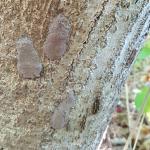 Spotted Lanternfly: (Lycorma delicatula, SLF) is a non-native, invasive insect that feeds on over 103 species of plants, including many trees and shrubs that are important in our landscapes. It overwinters as an egg mass, which the adult female insect lays on just about any flat surface. Pictures of egg masses can be seen here: https://massnrc.org/pests/linkeddocuments/SLFChecklistForResidents.pdf .
Spotted Lanternfly: (Lycorma delicatula, SLF) is a non-native, invasive insect that feeds on over 103 species of plants, including many trees and shrubs that are important in our landscapes. It overwinters as an egg mass, which the adult female insect lays on just about any flat surface. Pictures of egg masses can be seen here: https://massnrc.org/pests/linkeddocuments/SLFChecklistForResidents.pdf .
Take the new spotted lanternfly egg mass identification quiz from MDAR! Available here: bit.ly/SLFEggMassQuiz .
Spotted lanternfly egg masses are reported to have hatched in much of PA at this time. Connecticut is predicting spotted lanternfly egg hatch may occur over the next 1 to 2 weeks.
The MA Department of Agricultural Resources (MDAR) recently released the following “Notice to Nursery and Landscape Industry” regarding spotted lanternfly, an excerpt of which is included here:
Last year, the Massachusetts Department of Agricultural Resources (“MDAR”) detected populations of the invasive pest known as spotted lanternfly (Lycorma delicatula) in multiple locations throughout the state. Since this is the time of year that nurseries are receiving shipments of stock for the spring planting season, we are sending this notice to remind growers and landscapers to inspect any plant material coming from states where SLF has been found, to ensure it does not harbor SLF egg masses, and to report any finds to MDAR. This reminder is especially important as MDAR has recently received several reports that nursery stock from SLF-infested areas was sent to Massachusetts growers.
To read the FULL NOTICE, visit: https://massnrc.org/pests/blog/?p=2933 .
Currently, the only established populations of spotted lanternfly in Massachusetts are in a small area in both Fitchburg and Shrewsbury, MA. Therefore, there is no reason to be preemptively treating for this insect in other areas of Massachusetts. If you suspect you have found spotted lanternfly in additional locations, please report it immediately to MDAR here: https://massnrc.org/pests/slfreport.aspx . If you are living and working in the Fitchburg and Shrewsbury areas, please be vigilant and continue to report anything suspicious.
For More Information:
From UMass Extension:
Check out the InsectXaminer Episode about spotted lanternfly adults and egg masses! Available here: https://ag.umass.edu/landscape/education-events/insectxaminer
Fact Sheet: https://ag.umass.edu/landscape/fact-sheets/spotted-lanternfly
From the MA Department of Agricultural Resources:
Fact Sheet and Map of Locations in MA: https://massnrc.org/pests/pestFAQsheets/spottedlanternfly.html
-
Asian Longhorned Beetle: (Anoplophora glabripennis, ALB) Look for signs of an ALB infestation which include perfectly round exit holes (about the size of a dime), shallow oval or round scars in the bark where a female has chewed an egg site, or sawdust-like frass (excrement) on the ground nearby host trees or caught in between branches. Be advised that other, native insects may create perfectly round exit holes or sawdust-like frass, which can be confused with signs of ALB activity.
The regulated area for Asian longhorned beetle is 110 square miles encompassing Worcester, Shrewsbury, Boylston, West Boylston, and parts of Holden and Auburn. If you believe you have seen damage caused by this insect, such as exit holes or egg sites, on susceptible host trees like maple, please call the Asian Longhorned Beetle Eradication Program office in Worcester, MA at 508-852-8090 or toll free at 1-866-702-9938.
To report an Asian longhorned beetle find online or compare it to common insect look-alikes, visit: http://massnrc.org/pests/albreport.aspx or https://www.aphis.usda.gov/pests-diseases/alb/report .
-
Browntail Moth: Euproctis chrysorrhoea is an invasive insect originating from Europe and first detected in the US in Somerville, MA in 1897. Currently, browntail moth is limited to a small portion of eastern Massachusetts, particularly areas near the coast. Report suspected browntail moth life stages here: https://massnrc.org/pests/pestreports.htm . Due to a persistent outbreak of this insect in Maine since approximately 2016, it is a good idea for us to again familiarize ourselves with this pest. (For more information and the latest updates about the status of this insect in Maine, visit: https://www.maine.gov/dacf/mfs/forest_health/invasive_threats/browntail_moth_info.htm .)
Caution: hairs found on the caterpillar and pupal life stages of this insect can cause a rash similar to poison ivy. Some individuals are very sensitive to browntail moth hairs and may also experience allergic reaction. The chance of interacting with browntail moth hairs increases between May and July, although they could be a problem at any time of year.
The larval or caterpillar stage of this insect is present from August until the following June (spending the winter in webs they create on the tips of host plant twigs). In the fall, groups of caterpillars are found creating webs around a tightly wrapped leaf (covered in bright white silk) where they will overwinter in groups of 25-400. These 2-4 inch long webs can be found on the ends of branches often on apple or red oak. As soon as leaves begin to open in the spring (usually by April), the caterpillars will crawl from their webs to feed on the new leaves. Caterpillars are fully grown around June and spin cocoons in which they pupate. These cocoons are also full of the irritating hairs and should be dealt with extreme caution. Adult moths emerge in July and females lay eggs on the undersides of leaves in masses of 200-400, covering them with hairs from their bodies. (Adults do not typically cause skin rashes.) Eggs hatch around August and September and larvae feed shortly before forming their overwintering webs.
The primary concern with this insect are the poisonous hairs found on the caterpillars. Contact with the caterpillar or its hairs can cause a rash similar to poison ivy in susceptible individuals. If hairs break off and blow around in the wind, they can cause difficulty breathing and headaches. While this insect can act as a defoliator in the larval stage, feeding on the leaves of many deciduous trees and shrubs, this activity may be secondary to concerns about public health risks. Care should be taken to avoid places infested with these caterpillars, exposed skin or clothing should be washed, and the appropriate PPE should be worn if working with these insects. Consult your physician if you have a reaction to the browntail moth.
-
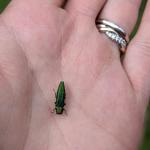 Emerald Ash Borer: (Agrilus planipennis, EAB) has been detected in at least 11 out of the 14 counties in Massachusetts. A map of these locations across the state may be found here: https://ag.umass.edu/fact-sheets/emerald-ash-borer . Additional information about this insect is provided by the MA Department of Conservation and Recreation, here: https://storymaps.arcgis.com/stories/b60f63199fa14805a8b9f7c82447a25b .
Emerald Ash Borer: (Agrilus planipennis, EAB) has been detected in at least 11 out of the 14 counties in Massachusetts. A map of these locations across the state may be found here: https://ag.umass.edu/fact-sheets/emerald-ash-borer . Additional information about this insect is provided by the MA Department of Conservation and Recreation, here: https://storymaps.arcgis.com/stories/b60f63199fa14805a8b9f7c82447a25b .
This wood-boring beetle readily attacks ash (Fraxinus spp.) including white, green, and black ash and has also been found developing in white fringe tree (Chionanthus virginicus) and has been reported in cultivated olive (Olea europaea). Signs of an EAB infested tree may include D-shaped exit holes in the bark (from adult emergence), “blonding” or lighter coloration of the ash bark from woodpecker feeding (chipping away of the bark as they search for larvae beneath), and serpentine galleries visible through splits in the bark, from larval feeding beneath. It is interesting to note that woodpeckers are capable of eating 30-95% of the emerald ash borer larvae found in a single tree (Murphy et al. 2018). Unfortunately, despite high predation rates, EAB populations continue to grow. However, there is hope that biological control efforts will eventually catch up with the emerald ash borer population and preserve some of our native ash tree species for the future. For an update about the progress of the biological control of emerald ash borer, visit Dr. Joseph Elkinton’s archived 2022 webinar now available here: https://ag.umass.edu/landscape/education-events/invasive-insect-webinars .
-
 Hemlock Woolly Adelgid: Adelges tsugae (HWA) is present on eastern and Carolina hemlock. The overwintering hemlock woolly adelgid generation (sistens) is present through mid-spring and produces the spring generation (progrediens) which will be present from early spring through mid-summer. HWA, unlike many other insects, does most of its feeding over the winter. Eggs may be found in woolly masses at the base of hemlock needles beginning in mid-March. Each woolly mass is created by a female who may then lay 50-300 eggs. Hemlock woolly adelgid eggs were observed in samples collected in Amherst, MA on April 13, 2022. Eggs hatch and crawlers may be found from mid-March through mid-July.
Hemlock Woolly Adelgid: Adelges tsugae (HWA) is present on eastern and Carolina hemlock. The overwintering hemlock woolly adelgid generation (sistens) is present through mid-spring and produces the spring generation (progrediens) which will be present from early spring through mid-summer. HWA, unlike many other insects, does most of its feeding over the winter. Eggs may be found in woolly masses at the base of hemlock needles beginning in mid-March. Each woolly mass is created by a female who may then lay 50-300 eggs. Hemlock woolly adelgid eggs were observed in samples collected in Amherst, MA on April 13, 2022. Eggs hatch and crawlers may be found from mid-March through mid-July.
Nicole Keleher, Massachusetts Department of Conservation and Recreation (DCR) and the Director of their Forest Health Program, reports some curious observations about the hemlock woolly adelgid population in Massachusetts this year. Out of 17 sites across the state that they monitored for HWA winter mortality, they averaged approximately 47% mortality of the adelgid over the winter. This is relatively low, in the context of recent year’s winter mortality. The 17 sites had adelgid winter mortality that ranged from 23% to 80% of the insects sampled, but most sites were in the 40-50% range – providing us with the 47% average. Given those percentages, and the fact that these insects reproduce parthenogenetically (females lay viable eggs without mating), MA DCR notes that they are seeing lower than expected densities of HWA right now. Anecdotally, they suspect this may be because of mortality in the spring progrediens generation, rather than the more typical winter mortality of the sistens generation. What is the reason for this? We are uncertain. Anecdotally, it also seems that hemlock woolly adelgid populations in western MA may be higher this season than those in eastern MA. Again, the reasons for these observations are currently unknown, and this information should be considered mostly anecdotal at this time.
What does all of this mean for hemlock woolly adelgid management this season? I am not sure. Perhaps trees in eastern MA may experience a bit of a reprieve from this insect in 2022, whereas those in western MA may not. However, as DCR notes there is site variability with their observations – so this information cannot be applied for every scenario. The important thing is to monitor specimen hemlock trees and shrubs in managed landscapes and make management decisions based on site-specific observations and historical recordkeeping at each individual location.
-
Winter Moth: (Operophtera brumata) data since 2017 has indicated that the winter moth population in eastern Massachusetts has been on the decline while the percent of winter moth pupae parasitized by Cyzenis albicans has increased! Dr. Joseph Elkinton’s laboratory at UMass Amherst has released this biological control of winter moth since 2005 and conducted the rigorous sampling required to determine where the insect has established and what its impact on the winter moth population has been at multiple sites in eastern MA. More information about the Elkinton Lab’s research and the biological control of winter moth can be found here: https://www.fs.fed.us/foresthealth/technology/pdfs/FHAAST-2018-03_Biology_Control_Winter-Moth.pdf .
The take-home point? Do not worry about winter moth this spring! In fact, management of this insect in landscaped settings will likely not be necessary in most locations. Blueberry and apple growers may still, on the other hand, be interested in scouting and continuing to monitor for this insect, as only very low numbers of winter moth caterpillars might be tolerated in those systems. For an April 16, 2022 update about winter moth in blueberry and apple production from Heather Faubert, University of Rhode Island, visit: https://web.uri.edu/ipm/2022/04/2667/ .
In recent years, it is worthwhile to note that some areas on the Cape and other locations in eastern MA have reported noticeable cankerworm populations in the spring, which are often confused for winter moth. Read more about cankerworms below.
Winter moth caterpillars will drop to the soil to pupate by late May/early June in Massachusetts. Once pupation occurs, management is no longer practical or necessary.
-
Jumping Worms: Amynthas spp. earthworms, collectively referred to as “jumping or crazy or snake” worms, overwinter as eggs in tiny, mustard-seed sized cocoons found in the soil or other substrate (ex. compost). The tiny, impossible to remove cocoons will overwinter and provide a population of these earthworms in the 2022 season.
For More Information:
UMass Extension Fact Sheets:
Earthworms in Massachusetts – History, Concerns, and Benefits: https://ag.umass.edu/landscape/fact-sheets/earthworms-in-massachusetts-history-concerns-benefits
Jumping/Crazy/Snake Worms – Amynthas spp.:
https://ag.umass.edu/landscape/fact-sheets/jumpingcrazysnake-worms-amynthas-spp
A Summary of the Information Shared at UMass Extension’s Jumping Worm Conference in January 2022:
https://ag.umass.edu/news-events/highlights/jumping-worms-conference
Tree & Shrub Insect Pests, Continued:
-
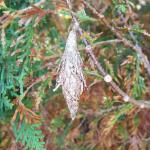 Bagworm: Thyridopteryx ephemeraeformis is a native species of moth whose larvae construct bag-like coverings over themselves with host plant leaves and twigs. This insect overwinters in the egg stage, within the bags of deceased females from last season. Eggs may hatch and young larvae are observed feeding around mid-June, or roughly between 600-900 GDD’s. Now is the time to scout for and remove and destroy overwintering bags. More information can be found here: https://ag.umass.edu/landscape/fact-sheets/bagworm A note about bagworms: there are approximately 28 different species of bagworm moths in North America belonging to the family Psychidae. The common bagworm (T. ephemeraeformis) is not active right now, but other species may be.
Bagworm: Thyridopteryx ephemeraeformis is a native species of moth whose larvae construct bag-like coverings over themselves with host plant leaves and twigs. This insect overwinters in the egg stage, within the bags of deceased females from last season. Eggs may hatch and young larvae are observed feeding around mid-June, or roughly between 600-900 GDD’s. Now is the time to scout for and remove and destroy overwintering bags. More information can be found here: https://ag.umass.edu/landscape/fact-sheets/bagworm A note about bagworms: there are approximately 28 different species of bagworm moths in North America belonging to the family Psychidae. The common bagworm (T. ephemeraeformis) is not active right now, but other species may be. -
Black Turpentine Beetle: Dendroctonus terebrans adults may begin to be active between mid-April to mid-May. Host plants include: black pine (Pinus thunbergiana), eastern white pine (Pinus strobus), Japanese black pine (Pinus thunbergii), loblolly pine (Pinus taeda), pitch pine (Pinus rigida), red spruce (Picea rubens), Scots pine (Pinus sylvestris), and slash pine (Pinus elliottii).
This is one of the largest native North American bark beetles. In the northern parts of its extensive range, the black turpentine beetle overwinters as an adult in the bark of its hosts. In the southern portions of its range, all life stages may be present throughout the year. Egg laying and feeding is usually kept to the basal 6 feet of the host plant. Mated pairs of adult beetles work to excavate galleries that may be 9.8 inches wide and 11.8 inches long. 100-200 eggs may be laid on one side of the gallery. Once hatched, larvae feed in groups on the inner bark. Fully grown larvae are legless, white, and almost 1/2 inch in length. Pupation occurs and adults eventually emerge from the bark to re-infest the same tree, or disperse to another susceptible host.
Stumps and buttress roots of freshly cut trees are favored by this insect. Attacked trees may exhibit browning of needles and oozing of large masses of pitch. Masses of pitch (pitch tubes) may cover holes in the trunk and may be considerably larger than those of southern pine beetle. Pitch hardens and is first white but may turn red as it ages. Pitch is irregular in shape and up to 1.6 inches in diameter. Pitch tubes are not visible when the area below the soil line is attacked. Healthy trees are usually not attacked, however it has been reported on occasion.
Check drought-stressed or otherwise stressed trees for needles turning light green to rust color. Check the lower 6 feet, particularly the lower 18 inches of the trunk for 1.6 inch in diameter pitch tubes or small entrance holes from the adults. Reddish-brown boring dust may be found near the base of the tree as well.
-
Boxwood Leafminer: Monarthropalpus flavus partly grown fly larvae overwinter in the leaves of susceptible boxwood. Yellowish mines may be noticeable on the undersides of leaves. This insect grows rapidly in the spring, transforming into an orange-colored pupa. After pupation, adults will emerge and white colored pupal cases may hang down from the underside of leaves where adults have emerged. Adults may be observed swarming hosts between 300-650 GDD’s, or roughly the end of May through June. Most cultivars of Buxus sempervirens and B. microphylla are thought to be susceptible. If installing new boxwoods this spring, resistant cultivars such as ‘Vardar Valley’ and ‘Handsworthiensis’ are good choices at sites where this insect has been a problem.
-
Boxwood Mite: Eurytetranychus buxi overwinter as tiny eggs on boxwood leaves and hatch mid-spring. These mites are tiny (about the size of a period) and difficult to detect. Feeding may cause plants to appear off-color. If management is deemed necessary, the timing for treatment may be between 245-600 GDD’s.
-
Boxwood Psyllid: Psylla buxi feeding can cause cupping of susceptible boxwood leaves. Leaf symptoms/damage may remain on plants for up to two years. English boxwood may be less severely impacted by this pest. Eggs overwinter, buried in budscales, and hatch around budbreak of boxwood. Eggs may hatch around 80 GDD’s. While foliar applications may be made between 290-440 GDD’s, the damage caused by this insect is mostly aesthetic. Therefore, typically, management is not necessary.
-
Cankerworms: Alsophila pometaria (fall cankerworm) and Paleacrita vernata (spring cankerworm) are often confused for winter moth (Operophtera brumata). Cankerworm populations in eastern MA, particularly on areas of Cape Cod, were confused for winter moth in 2019. Spring cankerworm adults are active in February and March, and fall cankerworm adults are active in late November into early December. During these times, both species lay eggs. These native insects most commonly utilize elm, apple, oak, linden, and beech. Eggs of both species hatch as soon as buds begin to open in the spring. Caterpillars occur in mixed populations and are often noticeable by mid-May in MA. Young larvae will feed on buds and unfolding leaves. There are two color forms (light green and dark) for caterpillars of both species. Like winter moth, they will drop to the soil to pupate. This usually occurs in June. Fall cankerworm larvae have three pairs of prolegs (one of which is small so it is sometimes referred to as ½) and spring cankerworm have two pairs. (Winter moth caterpillars also have 2 pairs of prolegs.) If populations are large and damage is noticeable on hosts, reduced risk insecticides such as Bacillus thuringiensis Kurstaki or spinosad may target larvae between approximately 148-290 GDD’s.
-
Dogwood Borer: Synanthedon scitula is a species of clearwing moth whose larvae bore not only into dogwood (Cornus), but hosts also include flowering cherry, chestnut, apple, mountain ash, hickory, pecan, willow, birch, bayberry, oak, hazel, myrtle, and others. Kousa dogwood appear to be resistant to this species. Signs include the sloughing of loose bark, brown frass, particularly near bark cracks and wounds, dead branches, and adventitious growth. The timing of adult emergence can be expected when dogwood flower petals are dropping and weigela begins to bloom. Adult moth flights continue from then until September. Emergence in some hosts (ex. apple) appears to be delayed, but this differs depending upon the location in this insect’s range. Eggs are laid singly, or in small groups, on smooth and rough bark. Female moths preferentially lay eggs near wounded bark. After hatch, larvae wander until they find a suitable entrance point into the bark. This includes wounds, scars, or branch crotches. This insect may also be found in twig galls caused by other insects or fungi. Larvae feed on phloem and cambium. Fully grown larvae are white with a light brown head and are approx. ½ inch long. Pheromone traps and lures are useful for determining the timing of adult moth emergence and subsequent management.
-
Dogwood Sawfly: Macremphytus tarsatus has one generation per year. The larvae of the dogwood sawfly overwinter in decaying wood and occasionally compromised structural timber. An overwintering "cell" is created in this soft wood. Pupation occurs in the springtime and adults can take a lengthy time to emerge, roughly between late May and July. 100+ eggs are laid in groups on the underside of leaves. Eggs hatch and the larvae feed gregariously, initially skeletonizing leaves. As the caterpillars grow in size, they are capable of eating the entire leaf with the exception of the midvein. Larval appearance varies greatly throughout instars, so much so that one might mistake them for multiple species. Early instars are translucent and yellow, but as the caterpillars grow they develop black spots (over yellow) and become covered in a white powder-like material. Larvae and their shed skins may resemble bird droppings. Full grown larvae begin to wander in search of a suitable overwintering location. Rotting wood lying on the ground is preferred for this. Foliage of dogwood, especially gray dogwood (Cornus racemosa) may be impacted. Skeletonizes leaves at first, then eats all but the midvein.
-
Eastern Tent Caterpillar: Malacosoma americanum eggs overwinter on host plant twigs. Egg hatch typically occurs when wild cherry leaves begin to unfold and young caterpillars may emerge by late-April through the first two weeks in May (90-190 GDD’s). Susceptible hosts include cherry and crabapple. Other host plants whose leaves are fed upon by this native insect can include apple, ash, birch, willow, maple, oak, poplar, and witch-hazel. Where practical, prune out and remove new eastern tent caterpillar tents before they become larger as the caterpillars continue to feed. Eastern tent caterpillars are native to Massachusetts and have many associated natural enemies (parasites and predators) that help regulate populations. Unless these caterpillars are actively defoliating specimen trees in a landscaped setting, we can coexist with this particular herbivore native to our forests.
-
Elm Leaf Beetle: Xanthogaleruca (formerly Pyrrhalta) luteola is found on American elm (Ulmus americana; not preferred), Chinese Elm (Ulmus parvifolia; not preferred), English Elm (Ulmus procera; preferred host), Japanese Zelkova (Zelkova serrata), and Siberian Elm (Ulmus pumila; preferred host).
This species was accidentally introduced into the eastern United States early in the 1800's. Since then, it has been found throughout the USA anywhere elms are located. It also occurs in eastern Canada. The adult elm leaf beetle overwinters in protected areas, such as the loose bark of trees, but can also be a nuisance when it tries to invade homes in search of overwintering protection. Beetles will try to enter houses or sheds in the fall.
In the spring, the adult beetles will fly back to the host plant and chew small, semi-circular holes in the leaves. The adult female can lay 600-800 yellow eggs in her life. Eggs are laid in clusters on the leaves and resemble pointy footballs. Larvae are tiny, black, and grub-like when they hatch from the egg. Young larvae will skeletonize the undersides of leaves. As they grow in size, the larvae become yellow-green with rows of black projections. Oldest larvae may appear to have two black stripes along their sides, made from the black projections. There are 3 larval instars. Mature larvae will wander down the trunk of the host tree and pupate in the open on the ground at the tree base or in cracks and crevices in the trunk or larger limbs. They spend approximately 10 or so days as a pupa, and then the adults emerge. Those adults will fly to the foliage of the same host plant or other adjacent potential hosts in the area, where they will lay eggs. In the fall, the adults will leave the host plant in search of overwintering shelter. In most locations in the USA, two generations of this insect are possible per year. In warmer locations, 3-4 generations per year are possible.
Leaves are skeletonized by the larvae. Skeletonization may cause the leaf to turn brown or whitish. Adults are capable of chewing through the leaf, often in a shothole pattern. When in very large populations, they are capable of completely defoliating plants. Populations of this insect can fluctuate from year to year, and often management is not necessary if populations are low. However, defoliation for consecutive seasons may lead to branch dieback or death of the entire tree.
-
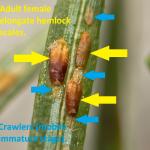 Elongate Hemlock Scale: Fiorinia externa is found on eastern, Carolina, and Japanese hemlock, as well as yew, spruce, and fir. The elongate hemlock scale may overwinter in various life stages and overlap of many developmental stages at any given time can be observed throughout much of the season. Treatments for the crawler, or mobile, stage of this insect may be made in late May through mid-June, or between 360-700 GDD’s, base 50°F. Nitrogen fertilizer applications may make elongate hemlock scale infestations worse.
Elongate Hemlock Scale: Fiorinia externa is found on eastern, Carolina, and Japanese hemlock, as well as yew, spruce, and fir. The elongate hemlock scale may overwinter in various life stages and overlap of many developmental stages at any given time can be observed throughout much of the season. Treatments for the crawler, or mobile, stage of this insect may be made in late May through mid-June, or between 360-700 GDD’s, base 50°F. Nitrogen fertilizer applications may make elongate hemlock scale infestations worse. -
Euonymus Scale: Unaspis euonymi is an armored scale that can be found on euonymus, holly, bittersweet, and pachysandra. This insect can cause yellow spotting on leaves, dieback, and distorted bark. For crawlers, early June timing is suggested between 533-820 GDD’s. (Eggs begin to hatch in early June.)
-
European Pine Sawfly: Neodiprion sertifer overwinters in the egg stage. Eggs are laid by females the previous season by cutting slits in needles using their ovipositors and depositing 6-8 eggs in each of 10-12 needles. Egg hatch occurs from late-April to mid-May and caterpillars become active roughly between 78-220 GDD, base 50°F. The primary host in MA is Mugo pine but it can be found on Scots, red, jack, and Japanese red pine. It is also found on white, Austrian, ponderosa, shortleaf, and pitch pine when planted near the aforementioned species. This dark colored caterpillar feeds in tight groups and small numbers can be pruned or plucked out of host plants and destroyed. Spinosad products can be used whenever the caterpillars are actively feeding, usually by mid-May and when caterpillars are still small. Bacillus thuringiensis kurstaki is not effective against sawflies.
-
Fletcher Scale: Parthenolecanium fletcheri is a soft scale pest of yew, juniper, and arborvitae. Feeding scales, especially on yew, result in honeydew and sooty mold, needle yellowing, and at times, premature needle drop. There is one generation per year. Overwintered second instar nymphs can be targeted between 38-148 GDD’s, base 50°F. Nymphs develop and adult females lay eggs (on average 500-600) in May that hatch by June. Dead females conceal egg masses beneath. Crawlers migrate short distances to branches and may be concentrated on certain branches of a particular plant.
-
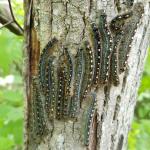 Forest Tent Caterpillar: Malacosoma disstria egg hatch occurs between 192-363 GDD’s, base 50°F, by mid-late May and caterpillars may be active for at least 5-6 weeks following. Susceptible hosts whose leaves are fed on by this insect include oak, birch, ash, maple, elm, poplar, and basswood. This native insect has many natural enemies, including some very effective pathogens that typically regulate populations. However, outbreaks of this insect can occur on occasion.
Forest Tent Caterpillar: Malacosoma disstria egg hatch occurs between 192-363 GDD’s, base 50°F, by mid-late May and caterpillars may be active for at least 5-6 weeks following. Susceptible hosts whose leaves are fed on by this insect include oak, birch, ash, maple, elm, poplar, and basswood. This native insect has many natural enemies, including some very effective pathogens that typically regulate populations. However, outbreaks of this insect can occur on occasion. -
Hemlock Looper: Two species of geometrid moths in the genus Lambdina are native insects capable of defoliating eastern hemlock, balsam fir, and white spruce. Adult moths lay their eggs on the trunk and limbs of hosts in September and October, and eggs will hatch by late May or early June. (L. fiscellaria caterpillars may be active between 448-707 GDD’s.) Monitor susceptible hosts for small, inch-worm like caterpillars. Where populations are low, no management is necessary. Hemlock loopers have several effective natural enemies.
- Holly Leafminers: Seven species of leaf miners feed on holly. Phytomyza ilicicola is usually referred to as the native holly leafminer. This species is known to feed on Ilex opaca, I. crenata, and related cultivars; however, it only lays its eggs in American holly (Ilex opaca). Some research suggests that the native holly leafminer may lay its eggs in other Ilex species, but that the larvae are unable to complete their development. This insect is found throughout the native range of its host plants. Larvae overwinter in leaf mines and pupation occurs in March and April and adult emergence by mid-May (192-298 GDD’s, base 50°F). Adult flies are known to emerge over a period of 6 or so weeks in the spring. Females lay eggs using their ovipositor on the underside of newly formed leaves. A tiny green blister forms on the leaf as the first symptom of injury. Larvae hatch from the egg and create a narrow mine that may appear brown from the upper leaf surface. Mines are broadened in the fall and a large blotch is completed in the winter. Larvae are yellow maggots and reach 1.5 mm. in length when mature. Current year’s mines are easily overlooked due to the slow feeding patterns of the larvae. Premature leaf drop may occur. Remove and destroy mined leaves before May. Phytomyza ilicis is usually only referred to as the holly leafminer, and it is a non-native species introduced from Europe and only feeds on Ilex aquifolium. (The native holly leaf miner does not develop in I. aquifolium.) The biology and damage this insect causes is similar to that of the native holly leafminer, with the exception of the fact that eggs are laid in the midvein of the leaf and young larvae tunnel in the vein until the fall. Remove and destroy mined leaves before May. Adults may be present mid-late May (246-448 GDD’s, base 50°F).
-
Honeylocust Plant Bug: Diaphnocoris chlorionis feeding results in tiny yellowish-brownish spots on leaves, leaf distortion, and in some cases, defoliation. (There are at least 7 species of plant bugs that feed on honeylocust, Gleditsia triacanthos.) There is one generation per year. Immatures and adults feed on foliage and light to moderately damaged foliage may persist throughout the growing season. Honeylocust plant bugs overwinter as eggs laid just beneath the bark surface of 2- and 3-year-old twigs. Eggs hatch just after vegetative buds of the host begin to open. Young nymphs crawl to the opening leaflets and begin feeding and the most significant damage occurs at that time, when the insect is hidden from view. Nymphs develop into adults around May-July. This insect can be targeted between 58-246 GDD’s, base 50°F.
 Imported Willow Leaf Beetle: Plagiodera versicolora adult beetles overwinter near susceptible hosts. Adult beetles will chew holes and notches in the leaves of willow once they become available. Females lay yellow eggs in clusters on the undersides of leaves. Larvae are slug-like and bluish-green in color. They will feed in clusters and skeletonize the leaves. Most plants can tolerate multiple years of feeding from this insect, and foliage will appear brown. Repeated yearly feeding can occasionally be an issue, in which case management of the young larvae may be necessary. Take care with treatment in areas near water.
Imported Willow Leaf Beetle: Plagiodera versicolora adult beetles overwinter near susceptible hosts. Adult beetles will chew holes and notches in the leaves of willow once they become available. Females lay yellow eggs in clusters on the undersides of leaves. Larvae are slug-like and bluish-green in color. They will feed in clusters and skeletonize the leaves. Most plants can tolerate multiple years of feeding from this insect, and foliage will appear brown. Repeated yearly feeding can occasionally be an issue, in which case management of the young larvae may be necessary. Take care with treatment in areas near water.
Check out Episode 4 of InsectXaminer to see the imported willow leaf beetle in action: https://ag.umass.edu/landscape/education-events/insectxaminer
-
Lecanium Scales (Oak): Parthenolecanium quercifex overwinters as a second instar nymph on oak twigs. Females will begin feeding and mature in the spring, from mid-April to early May and eggs may be laid between late May and into June. Eggs hatch in June or early July and crawlers migrate to host plant leaves where they spend the summer and migrate as second instars back to host plant twigs in the fall.
-
Lilac Borer: Podosesia syringae is a clearwing moth pest of lilac, privet, fringetree, and ash. (It is also known as the ash borer, not to be confused with the emerald ash borer.) Adults mimic paper wasps. Larvae are wood-boring, and signs and symptoms include branch dieback, holes, and occasionally, sawdust-like frass accumulated on bark. Larvae bore into stems, trunks, and branches, chewing an irregularly shaped entrance hole. Peak adult moth flights may occur in the northern portion of this insect’s range in June and are usually over by August 1st. Pheromone traps can be used to time adult emergence. Adult females lay flattened, oval, and tan eggs that are deposited singly or in clusters on bark crevices, ridges, and sometimes smooth bark; but usually laid in or near wounds in the bark. On average, 395 eggs are laid by each female. After hatch, larvae chew into the bark and feed laterally and then vertically in phloem tissue. Larvae overwinter in tunnels in the final instar and resume feeding in the spring. Adults emerge through a round exit hole (4-5 mm. in diameter). This insect may be targeted between 200-299 GDD’s, base 50°F.
-
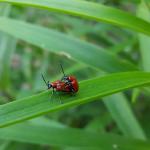 Lily Leaf Beetle: Lilioceris lilii adults overwinter in sheltered places. As soon as susceptible hosts such as Lilium spp. (Turk’s cap, tiger, Easter, Asiatic, and Oriental lilies) and Fritillaria spp. break through the ground, the adult lily leaf beetles are known to feed on the new foliage. (Note: daylilies are not hosts.) Typically, in May, mating will occur and each female will begin to lay 250-450 eggs in neat rows on the underside of the foliage. If there are only a few plants in the garden, hand picking and destroying overwintering adults can help reduce local garden-level populations at that time.
Lily Leaf Beetle: Lilioceris lilii adults overwinter in sheltered places. As soon as susceptible hosts such as Lilium spp. (Turk’s cap, tiger, Easter, Asiatic, and Oriental lilies) and Fritillaria spp. break through the ground, the adult lily leaf beetles are known to feed on the new foliage. (Note: daylilies are not hosts.) Typically, in May, mating will occur and each female will begin to lay 250-450 eggs in neat rows on the underside of the foliage. If there are only a few plants in the garden, hand picking and destroying overwintering adults can help reduce local garden-level populations at that time.
Check out Episode 3 of InsectXaminer to see the lily leaf beetle in action: https://ag.umass.edu/landscape/education-events/insectxaminer
-
Magnolia Scale: Neolecanium cornuparvum overwinters as first instar nymphs which are elliptical, and dark slate gray in color and can usually be found on the undersides of 1 and 2 year old twigs. Nymphs may molt by late April or May and again by early June at which time the scales may be purple in color. Eventually nymphs secrete a white powdery layer of wax over their bodies.
- Rhododendron Borer: Synanthedon rhododendri is one of the smallest of the native clearwing moths. Rhododendrons are preferred hosts, although mountain laurel, and deciduous azaleas can be heavily infested, especially if they are planted in close proximity to rhododendrons. Injury may be first noticed in the fall (leaves lose their sheen, then become pale green, then olive, then chlorotic) and can look similar to drought stress. On branches that seem to be stunted, look at limb crotches, scars, and other irregularities for sawdust stuck on bark or on the ground beneath these areas. In late May and early June, holes may contain pupal shed skins extending halfway out. Moth emergence occurs in the late-spring, early-summer. After mating, female moths seek out suitable egg laying locations (preferring wounded areas or limb crotches). The female lays her eggs and dies. Eggs hatch and larvae tunnel into the inner bark where they feed in tunnels that become packed with reddish frass pellets. By late fall, larvae move to the sapwood where they overwinter and resume feeding by mid-March. Pupation occurs in the spring and there is one generation per year. Prune out and destroy infested branches before late May/June. Monitor for adults in mid-May (192-298 GDD’s, base 50°F).
-
Snowball Aphid: Neoceruraphis viburnicola eggs overwinter on viburnum twigs and buds. Eggs hatch and this aphid becomes active on certain species of viburnum roughly between 148-298 GDD’s or around redbud bloom. This insect is particularly noticeable on V. opulus, V. prunifolium, and V. acerifolia. Stem mothers, appearing blueish-white, can be found in curled up and distorted foliage. Damage caused by this insect pest is mostly aesthetic.
-
Spruce Bud Scale: Physokermes piceae is a pest of Alberta and Norway spruce, among others. Immatures overwinter on the undersides of spruce needles, dormant until late March. By April, females may move to twigs to complete the rest of their development. Mature scales are reddish brown, globular, 3 mm. in diameter, and found in clusters of 3-8 at the base of new twig growth. They closely resemble buds and are often overlooked. Crawlers are present around June.
-
Spruce Spider Mite: Oligonychus ununguis is a cool-season mite that becomes active in the spring from tiny eggs that have overwintered on host plants. Hosts include spruce, arborvitae, juniper, hemlock, pine, Douglas-fir, and occasionally other conifers. This particular species becomes active in the spring and can feed, develop, and reproduce through roughly June. When hot, dry summer conditions begin, this spider mite will enter a summer-time dormant period (aestivation) until cooler temperatures return in the fall. This particular mite may prefer older needles to newer ones for food. Magnification is required to view spruce spider mite eggs. Tapping host plant branches over white paper may be a useful tool when scouting for spider mite presence. (View with a hand lens.) Spider mite damage may appear on host plant needles as yellow stippling and occasionally fine silk webbing is visible. Be sure to also scout for predatory mite adults and eggs which can help regulate spruce spider mite populations. Avoid broad spectrum chemical management options that kill predatory mite populations, often making spruce spider mite outbreaks worse.
-
Taxus Mealybug: Dysmicoccus wistariae will produce honeydew and lead to sooty mold growth, yellowing of needles, and sparsely foliated plants. Eventual dieback may be possible. This species is commonly associated with taxus in New England, but can be occasionally found on dogwood, rhododendron, Prunus spp., maple, andromeda, and crabapple. These mealybugs are found on stems and branches and particularly like to congregate at branch crotches. Taxus mealybug feeds in the inner bark tissue of the trunk and branches. Adult females are present from June to August and give birth to living young in the summer. Immatures overwinter. A single generation may occur per year in New England, but areas to the south can have multiple generations of this insect. Management may be targeted between 246-618 GDD’s, base 50°F. Horticultural oil and neem oil may be used.
-
Viburnum Leaf Beetle: Pyrrhalta viburni is a beetle in the family Chrysomelidae that is native to Europe, but was found in Massachusetts in 2004. Viburnum leaf beetle overwinters as eggs laid in capped pits on the newest growth of susceptible viburnum branches. Scout for overwintered eggs and prune out and destroy before they hatch. Egg hatch occurs in late-April to early-May as temperatures warm and foliage becomes available. Monitor for larvae in mid-May (80-120 GDD’s). This beetle feeds exclusively on many different species of viburnum, which includes, but is not limited to, susceptible plants such as V. dentatum, V. nudum, V. opulus, V. propinquum, and V. rafinesquianum. Some viburnum have been observed to have varying levels of resistance to this insect, including but not limited to V. bodnantense, V. carlesii, V. davidii, V. plicatum, V. rhytidophyllum, V. setigerum, and V. sieboldii. More information about viburnum leaf beetle may be found at http://www.hort.cornell.edu/vlb/ .
-
White Spotted Pine Sawyer (WSPS): Monochamus scutellatus adults can emerge in late May throughout July, depending on local temperatures. This is a native insect in Massachusetts and is usually not a pest. Larvae develop in weakened or recently dead conifers, particularly eastern white pine (Pinus strobus). However, the white spotted pine sawyer looks very similar to the invasive Asian Longhorned Beetle, Anoplophora glabripennis, ALB. ALB adults do not emerge in Massachusetts until July and August. Beginning in July, look for the key difference between WSPS and ALB adults, which is a white spot in the top center of the wing covers (the scutellum) on the back of the beetle. White spotted pine sawyer will have this white spot, whereas Asian longhorned beetle will not. Both insects can have other white spots on the rest of their wing covers; however, the difference in the color of the scutellum is a key characteristic. See the Asian longhorned beetle entry above for more information about that non-native insect.
-
Woolly Apple Aphid: Eriosoma lanigerum may be found on apple, crabapple, hawthorn, mountain-ash, Pyracantha, and elm hosts. The primary (winter) host is elm, on which aphids infest emerging spring leaves, causing leaves to curl or close into stunted, rosette-like clusters found at twig tips. On apple and crabapple, this species of aphid colonizes roots, trunks, and branches in the summer and is commonly found near previous wounds or callous tissue. On roots, the aphids cause swelled areas which can girdle and kill roots. The aphids, when found in above ground plant parts such as elm leaves, are covered with white wax. Eggs are the overwintering stage on elm, which hatch in the spring in time for the nymphs to infest new elm foliage. Following a few generations on elm, the aphids will develop into a winged form, which will disperse and seek out apple and crabapple. Multiple generations will occur on these alternate hosts in the summer and by the fall, a winged form will return to elm and mated females will lay eggs near elm buds. These aphids are a favorite snack for insect predators such as the multicolored Asian lady beetle, Harmonia axyridis. Elm can withstand multiple years of woolly apple aphid infestation and this insect is primarily aesthetic in its impact to trees. Management may not be necessary.
-
Woolly Elm Aphid: Eriosoma americanum females lay a single egg in the cracks and crevices of elm bark, where the egg overwinters. Eggs hatch on elm in the spring as leaves are unfolding. Aphids may be active from 121-246 GDD’s, base 50°F on elm. A young, wingless female hatched from the egg feeds on the underside of leaf tissue. This female aphid matures and gives birth to 200 young, all females, without mating. These aphids feed, and the elm leaf curls around them and protects them. By the end of June, winged migrants mature and find serviceberry hosts. Another set of females is produced. These new females crawl to and begin feeding on the roots of serviceberry. Multiple generations occur on the roots of serviceberry through the summer. Elm can withstand multiple years of woolly elm aphid infestation and this insect is primarily aesthetic in its impact to trees. Management may not be necessary. Lady beetle larvae and adults often feed on these insects.
Concerned that you may have found an invasive insect or suspicious damage caused by one? Need to report a pest sighting? If so, please visit the Massachusetts Introduced Pests Outreach Project: http://massnrc.org/pests/pestreports.htm .
Reported by Tawny Simisky, Extension Entomologist, UMass Extension Landscape, Nursery, & Urban Forestry Program
Additional Resources
Pesticide License Exams - The MA Dept. of Agricultural Resources (MDAR) is now holding exams online. For more information and how to register, go to: https://www.mass.gov/pesticide-examination-and-licensing.
To receive immediate notification when the next Landscape Message update is posted, join our e-mail list or follow us on Facebook.
For a complete listing of upcoming events, see our upcoming educational events https://ag.umass.edu/landscape/upcoming-events
For commercial growers of greenhouse crops and flowers - Check out UMass Extension's Greenhouse Update website
For professional turf managers - Check out Turf Management Updates
For home gardeners and garden retailers - Check out our home lawn and garden resources.
Diagnostic Services
UMass Laboratory Diagnoses Landscape and Turf Problems - The UMass Extension Plant Diagnostic Lab is available to serve commercial landscape contractors, turf managers, arborists, nurseries and other green industry professionals. It provides woody plant and turf disease analysis, woody plant and turf insect identification, turfgrass identification, weed identification, and offers a report of pest management strategies that are research based, economically sound and environmentally appropriate for the situation. Accurate diagnosis for a turf or landscape problem can often eliminate or reduce the need for pesticide use. For sampling procedures, detailed submission instructions and a list of fees, see Plant Diagnostic Laboratory
Soil and Plant Nutrient Testing - The University of Massachusetts Soil and Plant Nutrient Testing Laboratory is located on the campus of The University of Massachusetts at Amherst. Testing services are available to all. The lab provides test results and recommendations that lead to the wise and economical use of soils and soil amendments. For more information, including current turn-around times, visit the UMass Soil and Plant Nutrient Testing Laboratory web site. The lab is currently accepting new orders for Routine Soil Analysis (including optional Organic Matter, Soluble Salts, and Nitrate testing), Particle Size Analysis, Pre-Sidedress Nitrate (PSNT), and Soilless Media (no other types of soil analyses available at this time). Turnaround time: Please plan for the fact that date of receipt in the lab is affected by weekends, holidays, shipping time, and time for UMass Campus Mail to deliver samples to the lab.
Tick Testing - The UMass Center for Agriculture, Food, and the Environment provides a list of potential tick identification and testing options at: https://ag.umass.edu/resources/tick-testing-resources.
Acknowledgements: UMass Extension gratefully acknowledges the support of the following funding sources for the production of the Landscape Message –
- The Massachusetts Nursery and Landscape Association Fund
- The Massachusetts Department of Conservation and Recreation, Award #ISADCR28219926UMA22A
- Stakeholders like you! The Landscape Message is partially supported by educational program user fees.